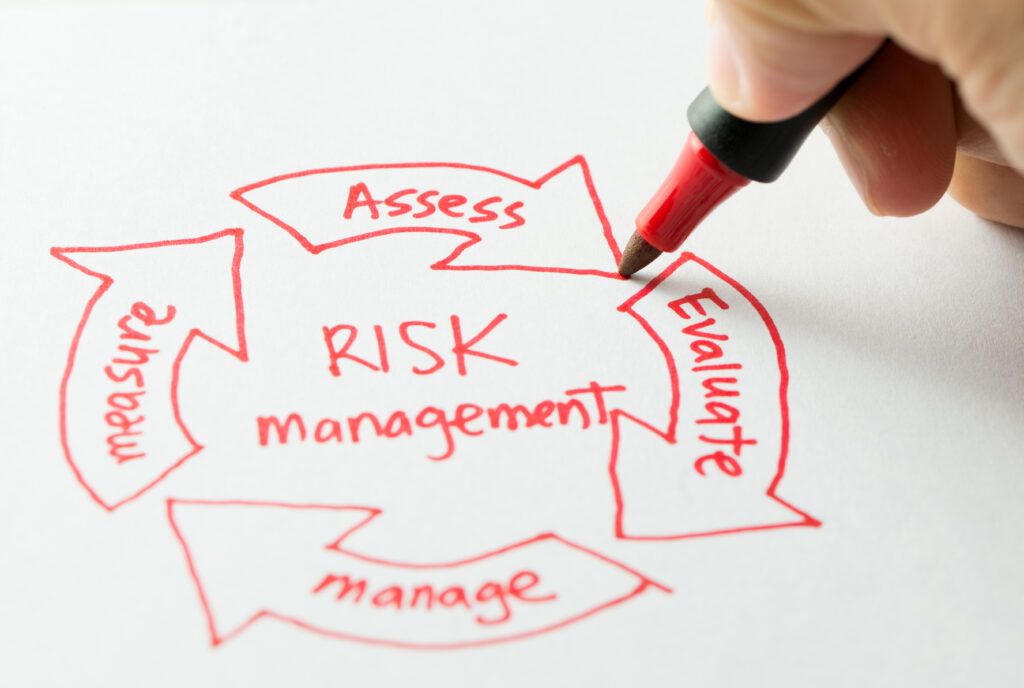When the Going Gets Tough: Practical Tips for Risk Management in Entrepreneurship
When the going gets tough, the tough get going.
In entrepreneurship, managing risk is a critical aspect of staying afloat in an ever-changing market. With volatile economic conditions and constant shifts in consumer demand, entrepreneurs need to be equipped with practical tips for risk management.
In this blog post, we will discuss strategies that can help entrepreneurs navigate uncertain times and keep their businesses thriving. Whether you’re just starting out or have been in the game for a while, these tips can be valuable tools in your arsenal. Let’s dive in!
Why Risk Management is Crucial for Entrepreneurship

Entrepreneurship is all about taking risks, but it’s also about mitigating those risks to ensure business sustainability and long-term success.
With the constant changes in the market, it’s essential for entrepreneurs to understand the importance of managing risk and implementing effective strategies to minimize potential setbacks.
Effective risk management allows entrepreneurs to make informed decisions based on data and analysis, which helps reduce the likelihood of failure. It enables entrepreneurs to identify potential risks that may arise and implement measures to prevent them from escalating.
In today’s volatile market, entrepreneurs must prioritize risk management to ensure they remain competitive and agile in the face of challenges. Risk management is not just about identifying risks but also about developing a risk mitigation plan that can minimize their impact on business operations.
Without proper risk management, entrepreneurs may be left vulnerable to a range of issues, including financial instability, legal problems, loss of reputation, and a decline in customer trust. To avoid such risks, entrepreneurs must be proactive in assessing and addressing potential hazards.
By prioritizing risk management, entrepreneurs can identify opportunities and leverage them to create growth and increase profitability. It also helps them make informed decisions based on data, enabling them to pivot and adapt quickly to changing market conditions.
Understanding the Market Volatility

Entrepreneurship is a risky venture.
While the potential for great rewards is high, so too is the possibility of failure. In today’s volatile market, managing risks is more crucial than ever before. As an entrepreneur, it is essential to understand the market volatility and the potential risks that come with it.
Market volatility refers to the rapid and significant changes in the value of assets or securities traded in the financial markets. In simpler terms, it means that the prices of stocks, bonds, and other financial instruments fluctuate rapidly. Market volatility can be caused by various factors, including global events, political instability, economic shifts, and industry trends.
For entrepreneurs, market volatility means that the demand for their products or services can change rapidly, affecting their revenues and profits. It can also impact their ability to secure funding or raise capital from investors. Understanding the market volatility and its impact on your business is the first step in managing risks effectively.
One of the ways to understand the market volatility is to keep up with the news and trends in your industry. Stay informed about any changes in the market and how they may impact your business. Analyze your competitors and see how they are faring in the market. Look at any past trends and identify the patterns that may impact your business in the future.
Another way to understand market volatility is to conduct market research. Gather data on your target audience and their buying behavior. Analyze your sales and revenue trends over a period and identify any seasonal or cyclical patterns. This will help you understand your market better and make informed decisions.
Conducting Risk Assessments

Before developing a risk mitigation plan, it is important to conduct a thorough risk assessment. This involves identifying potential risks and evaluating the likelihood and impact of each risk.
One approach to conducting a risk assessment is to use a risk matrix. This involves creating a grid that ranks risks based on their likelihood and impact. The likelihood is usually rated on a scale of 1-5, with 1 being highly unlikely and 5 being highly likely. The impact is usually rated on a scale of 1-5, with 1 being low impact and 5 being high impact. The risk matrix can then be used to prioritize risks based on their ranking.
Another approach to conducting a risk assessment is to use a SWOT analysis. This involves analyzing the business’s strengths, weaknesses, opportunities, and threats. By identifying potential threats to the business, entrepreneurs can develop strategies to mitigate those risks.
It is also important to involve stakeholders in the risk assessment process. This includes employees, customers, suppliers, and investors. By gathering input from all stakeholders, entrepreneurs can gain a more comprehensive understanding of potential risks and develop more effective risk mitigation strategies.
Overall, conducting a thorough risk assessment is a critical step in managing risk in entrepreneurship. By identifying and evaluating potential risks, entrepreneurs can develop effective strategies to mitigate those risks and ensure the long-term success of their business.
Identifying and Prioritizing Risks

Once you have conducted a risk assessment, it’s time to identify and prioritize the risks you’ve identified.
Not all risks are equal and some may have a bigger impact on your business than others. Identifying and prioritizing risks will help you determine which ones need immediate attention and which ones can be dealt with later.
To identify and prioritize risks, start by listing all the risks you’ve identified in the risk assessment. Group them into categories and identify the ones that are the most critical to your business. Consider the likelihood and impact of each risk. For example, a risk with a high likelihood and high impact should be given top priority.
Once you’ve identified and prioritized the risks, develop a plan to manage each one. Determine what steps you need to take to mitigate the risks, who will be responsible for managing them, and what resources you will need. It’s important to be realistic about what you can achieve and to focus on the risks that are most critical to your business.
Remember that risk management is an ongoing process, so it’s important to regularly monitor and re-evaluate the risks you’ve identified and prioritize. As your business evolves and market conditions change, new risks may emerge or existing risks may become less relevant. By regularly reviewing and prioritizing risks, you can ensure that your risk management plan stays relevant and effective.
Developing a Risk Mitigation Plan

Once you have identified and prioritized your risks, it’s time to create a plan for mitigating them. This is an essential step in risk management, as it helps to minimize the impact of potential risks on your business.
Your risk mitigation plan should include the following:
- Risk mitigation strategies. Develop various strategies that you can use to mitigate each identified risk. This may include risk avoidance, risk transfer, risk reduction, or risk acceptance.
- Responsibilities and roles. Clearly define who will be responsible for implementing the risk mitigation plan and their roles in the process.
- Timelines and deadlines. Set clear timelines and deadlines for implementing the risk mitigation plan. This will help you ensure that you take all necessary actions in a timely manner.
- Communication plan. Develop a communication plan that outlines how you will communicate the risk mitigation plan to all stakeholders. You should include a clear message about the importance of risk management and communicate the steps you are taking to minimize risks.
- Contingency plan. Finally, develop a contingency plan in case your risk mitigation plan fails. You should include alternative strategies for managing risks and regularly review and update them.
Remember, a risk mitigation plan is only effective if it is properly implemented and regularly reviewed and updated. By taking a proactive approach to risk management, you can help to safeguard your business and position it for success, even in a volatile market.
Building Resilience Through Diversification

Diversification is a key strategy for managing risks in entrepreneurship.
It involves spreading out your business across different markets, products or services, and customers to reduce the impact of potential failures. This approach can help your business to remain resilient in times of market volatility.
By diversifying, you can protect your business from the risk of market downturns, customer loss, or changes in consumer preferences. This strategy can help you stay agile and adapt quickly to the changing business environment.
For example, if your business is solely focused on one product or service, diversifying into different products or services can help to spread your risks. By offering multiple products or services, you can tap into a wider range of customer needs and preferences. This approach also enables you to maintain a steady revenue stream even when one product or service is not doing well.
Diversifying your market is also important in building resilience. Expanding into new geographic markets or targeting a different customer segment can provide your business with new opportunities for growth. This can be achieved through strategic partnerships, joint ventures or acquisitions.
However, it is important to be cautious in diversifying. Over-diversification can result in the loss of focus, increased costs and reduced profitability. It is essential to strike a balance between diversification and maintaining your core business operations.
Monitoring and Re-evaluating Risks

Once you have developed a risk mitigation plan and implemented strategies to reduce the potential impact of risks on your business, it is important to monitor and re-evaluate your risks regularly. This will help you stay ahead of potential threats to your business and make necessary adjustments to your strategies.
Regular monitoring of your risks will give you insights into the effectiveness of your risk mitigation strategies. It will also help you to detect any new or emerging risks that may not have been identified in the initial risk assessment. As market conditions change, the risks you face may also change, making it important to stay up to date with the latest developments and be prepared to adapt.
Re-evaluating your risks periodically will help you identify any new risks that have emerged and determine if the risks you have identified previously have become more or less critical. You may need to make changes to your risk mitigation plan to address these new or changing risks. For example, if your business has experienced a downturn due to a recession or market downturn, you may need to revisit your risk mitigation strategies to find ways to manage this new risk.
It is important to establish a regular review cycle for your risk management plan. This could include a monthly or quarterly review process to assess risks, identify changes, and alter risk mitigation techniques. You should also invite the senior management, team members, and external consultants to these review meetings.
Overall, monitoring and re-evaluating your risks is an essential part of successful risk management. By staying proactive and regularly assessing your risks, you can better prepare your business for any challenges that may arise in the volatile market.
Seeking Expert Advice and Collaboration

Even with a solid risk management plan in place, unexpected events can still happen.
In such cases, seeking the advice of experts and collaborating with other businesses can help mitigate the damage caused by a risk event.
When seeking expert advice, look for professionals who specialize in your industry and have experience dealing with similar risk events. Their insights can provide valuable guidance on how to mitigate or avoid risks altogether.
Collaboration with other businesses can also help minimize risk. By partnering with other companies in your industry, you can share knowledge and resources to help prepare for potential risks. For example, you could collaborate on crisis communication plans, supply chain diversification, or even joint ventures that help to reduce risk.
It’s important to establish clear communication channels with partners and to regularly review and update any agreements made. In addition, you should regularly monitor the effectiveness of your collaboration efforts and make adjustments as necessary.
Finally, don’t be afraid to seek out help from outside sources, such as business mentors or industry associations. These resources can provide additional guidance and support as you navigate risk management in entrepreneurship.
By seeking expert advice and collaborating with others, entrepreneurs can strengthen their risk management strategies and build resilience in the face of a volatile market.
Ready to sell your property? Give us a call today and learn more about our professional photography services and marketing that can boost your property listing!
Plus, explore our virtual assistant coaching program to level up your business. Don’t forget to tune into our new podcast for even more valuable insights!
